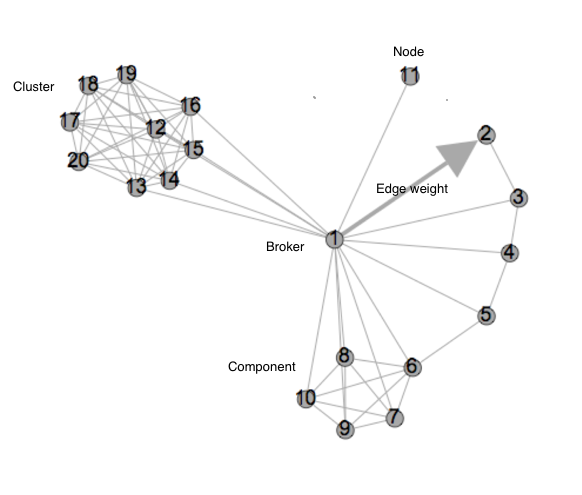Social Network Analysis concepts and methods are extremely powerful ways to describe complex social relations. The field however has developed their own their concepts, some of which require a little bit of translation. This cheat sheet should help with the very first steps.
| Actor | The entity which is described by a node, e.g. a person, an institution etc. |
| Alter/Alteri | Actors in an ego network |
| Broker | A node which is positioned e.g. between two clusters and can act as a “bottleneck” |
| Clique | A fully interconnected group of nodes |
| Community | A set of nodes which are relatively more connected to each other than to the rest of the graph |
| Co-occurrence network | A network in which the edge between nodes is based on the fact that both appear together in the same context, usually in texts. An example would be two people who are mentioned in the same paragraph. |
| Data | A set of individual pieces of information which are typically machine-readable |
| Data visualisation | The visualisation of data in general. Network visualisation is one of many subfields. |
| Dyad | A group of two connected nodes, the smallest possible network |
| Edge attribute | Data which describes a certain aspect of an edge, for example how often two actors speak to each other |
| Edge or tie or arc or link | What connects two nodes. There are slight differences between these terms but they are mostly used interchangeably |
| Ego network | A network which contains all connections of an actor to their alteri and usually also the connections between the alteri |
| Graph | (in a network and math. context): objects which are connected by links. However often used interchangeably with “network” even by experts. |
| Graph theory | The mathematical description of nodes and ties |
| Historical Network Research | SNA + historical research methods and questions |
| Hub | A node with a degree far higher than the average in a network |
| Layout algorithms | Algorithms which arrange a graph according to an underlying logical principle. Many different ones exist and can be fine-tuned by additional parameters. Layout algorithms help reveal patterns in the network data. So-called force-directed algorithms are used often: they consider ties to be “springs” which attract well-connected nodes and seek to avoid crossings between ties. The same data can look very differently with different layout algorithms and even the same algorithm will produce a different visualisation each time it is run; there is therefore not the “one” or “right” way to visualise a network. |
| Network dataset | Typically machine-readable data which contains information on edges between nodes, on node attributes, on the graph itself. |
| Network metaphor | The most common way to refer to networks in the humanities. It typically describes the observation that social relations have an effect on something or somebody without specifying it further. |
| Network theory | The theoretical approach to social networks which often inspires research and the development of algorithms |
| Network visualizations | Are visual representations of network data. Can take various forms, commonly used are node-link-diagrams and matrices |
| Node attribute | Data which describes a certain aspect of a node, for example an actor’s age or gender |
| Node centrality | Describes the extent to which a node is connected to other nodes within a network. Various algorithms exist to describe different aspects of such connectivity. To some extent centrality can be linked to abstract notions such as “influence”, “power” or “importance”. |
| Node or vertex | Refers to the object which is connected to other objects in a graph. The terms are often used interchangeably |
| Relationships | Any relationship between actors can be represented as an edge and two actors can be connected by multiple ties. When conceptualising network ties, it is important that they are defined clearly to allow comparison: What exactly is e.g. “friendship” or “collaboration” and when does it apply? |
| Software for network visualisation and analysis | Helps to create, compute, visualise, modify network data. Many different tools exist for different purposes. Gephi, NodeXL, UCINET, Pajek are among the most well-known |
| Social Network Analysis (SNA) | Is a cross-disciplinary field of research which is based on the axiom that the systematic study of relations between (mostly) humans (often exchanges of some kind) can help answer research questions. |
| Triad | Similar to a dyad, a triad describes a group of three nodes. The number of completed triads in a graph can also provide insight into the structure of the network. |
| Unipartite (or 1-mode), bipartite (or 2-mode) ndn-partite network | Unipartite networks describe relations between one type of nodes (e.g. people connected to people); bipartite networks describe relations between two types of nodes (e.g. people connected to organisations). A bipartite network can be projected into a unipartite network (people who were connected to the same organisation are now connected to each other). This concept can be expanded even further, in theory a network can have any number of types of actors. It is important to note that in these networks, nodes of the same type can never connect to each other, only to nodes of the other types. |
Cite this blog post
Marten Düring (2015, April 13). Cheat Sheet: Social Network Analysis for Humanists. Digital Humanities LAB at CVCE powered by uni.lu. Retrieved April 17, 2024, from https://doi.org/10.58079/nfu1

